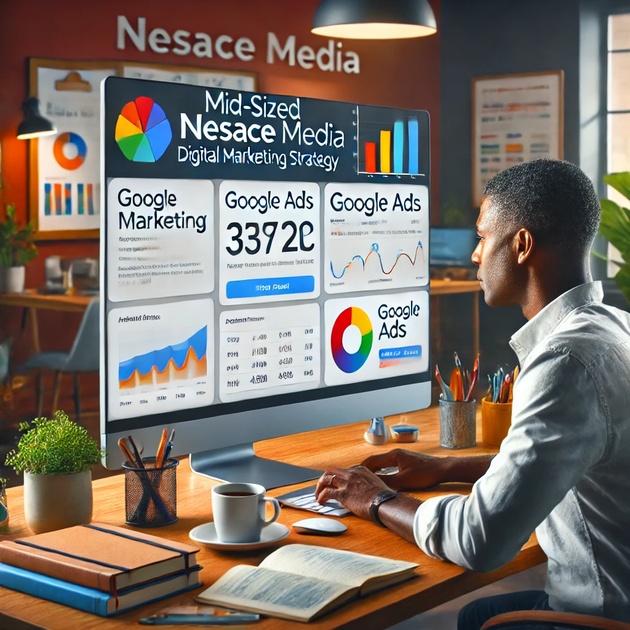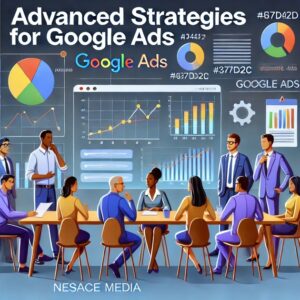Google Ads is an essential tool for mid-sized businesses aiming to enhance their online presence and drive targeted traffic. However, to truly benefit from Google Ads, it’s crucial to understand and implement best practices that align with your business objectives. This article will guide you through mastering Google Ads best practices, ensuring your campaigns are optimized for success.
Understanding Google Ads and Its Importance
Google Ads is a platform that allows businesses to display advertisements on Google’s search engine results pages (SERPs) and across its extensive advertising network. For mid-sized businesses, Google Ads offers a valuable opportunity to compete with larger companies by targeting specific audiences and driving measurable results.
Why Google Ads Is Vital for Mid-Sized Businesses
- Targeted Reach: Google Ads enables precise targeting based on keywords, demographics, location, and more, ensuring your ads reach potential customers most likely to convert.
- Measurable Results: Unlike traditional advertising, Google Ads provides detailed analytics, allowing businesses to track every aspect of their campaigns, from clicks to conversions.
- Scalability: Whether you’re working with a modest budget or looking to scale up, Google Ads can be tailored to fit your needs.
For a more in-depth understanding of how Google Ads can boost your business, you can check out this guide on boosting website traffic with Google Ads.
Setting the Foundation: The Basics of Google Ads
Defining Clear Objectives
Before launching any campaign, it’s critical to set clear objectives. These objectives will serve as the foundation for your campaign and help guide decisions related to budget, targeting, and ad copy.
- Brand Awareness: If you’re looking to increase visibility, focus on Display Ads that reach a broad audience.
- Lead Generation: For generating leads, Search Ads targeting specific keywords with high intent are ideal.
- Sales: Shopping Ads are perfect for e-commerce businesses looking to boost sales directly through Google Ads.
Keyword Research and Selection
Keywords are the backbone of any Google Ads campaign. Choosing the right keywords can mean the difference between a successful campaign and wasted ad spend.
Importance of Thorough Keyword Research
Conducting thorough keyword research is essential to identify the terms potential customers use when searching for products or services like yours.
- Keyword Planner: Google’s Keyword Planner is an excellent tool for discovering new keywords and estimating their performance.
- Competitor Analysis: Tools like SEMrush and Ahrefs can help you understand what keywords your competitors are targeting and how well they’re performing.
To delve deeper into effective keyword strategies, you can refer to our article on optimizing Google Ads for mid-sized business success.
Structuring Your Campaigns
Organizing your campaigns and ad groups effectively can greatly impact your performance. Proper structure allows for better budget allocation, targeting, and optimization.
- Campaign Segmentation: Divide campaigns by product categories, services, or goals to maintain focused targeting.
- Ad Groups: Within each campaign, create ad groups that focus on closely related keywords to ensure your ads are highly relevant.
Campaign Type Comparison
| Campaign Type | Best For | Pros | Cons |
|---|---|---|---|
| Search | High-intent searches | High conversion rates | Competitive bidding |
| Display | Brand awareness | Broad reach, visual impact | Lower conversion rates |
| Shopping | E-commerce | Direct product promotion | Limited to retail businesses |
Creating High-Quality Ads
Your ads are the first impression potential customers will have of your business. Ensuring they are compelling and relevant is crucial to driving clicks and conversions.
Crafting Compelling Ad Copy
Ad copy needs to be concise, persuasive, and aligned with the user’s search intent. Here are some tips to get it right:
- Use Actionable Language: Phrases like “Buy Now,” “Learn More,” or “Get Started” encourage users to take action.
- Highlight Unique Selling Points (USPs): What sets your business apart? Make sure your ads reflect your unique value proposition.
- Include Keywords in Headlines: Incorporating the primary keyword in your headline can improve ad relevance and Quality Score.
Leveraging Ad Extensions
Ad extensions provide additional information and increase the visibility of your ads. They can significantly enhance your ad’s performance by offering users more reasons to click.
- Sitelink Extensions: Direct users to specific pages on your website, such as product categories or contact pages.
- Call Extensions: Include your phone number in the ad, making it easy for mobile users to contact you directly.
- Location Extensions: Great for businesses with physical locations, this extension shows your address and increases local search relevance.
A/B Testing Your Ads
Continuous improvement is key to successful Google Ads campaigns. A/B testing different versions of your ad copy can help identify which messages resonate best with your audience.
- Headline Testing: Test different headlines to see which ones drive more clicks.
- CTA Variations: Experiment with different calls to action to find out which generates the most conversions.
- Ad Format Tests: Test different ad formats (e.g., text ads vs. responsive search ads) to see which performs better in your campaigns.
Optimizing Landing Pages
A well-optimized landing page is critical to converting clicks into customers. Even the best ads will fall short if your landing page doesn’t deliver.
Ensuring Relevance and Consistency
Your landing page should be a natural extension of your ad. If your ad promises a particular product or service, the landing page should deliver on that promise.
- Headline Matching: The headline on your landing page should match the headline of your ad to maintain consistency.
- Focused Content: Keep the content on your landing page focused on the offer or message of your ad. Avoid unnecessary distractions.
Improving Load Speed
A fast-loading landing page is essential, especially for mobile users. A delay of even a few seconds can lead to higher bounce rates and lost conversions.
- Optimize Images: Ensure images are compressed without sacrificing quality.
- Use a Content Delivery Network (CDN): A CDN can reduce load times by serving content from a server closest to the user’s location.
- Minimize HTTP Requests: Reduce the number of elements on your page that require HTTP requests, such as scripts and images.
Clear and Compelling CTAs
The call to action (CTA) on your landing page should be clear and compelling, guiding visitors towards taking the desired action.
- Visible and Accessible: Ensure the CTA is prominently displayed and easy to access, especially on mobile devices.
- Action-Oriented Language: Use strong verbs that clearly state what you want the user to do, such as “Sign Up Today” or “Get Your Free Quote.”
Advanced Strategies for Mid-Sized Businesses
To stay ahead of the competition, mid-sized businesses need to employ advanced strategies that go beyond the basics of Google Ads.
Audience Targeting and Remarketing
Audience targeting allows you to reach users based on specific demographics, behaviors, and interests, while remarketing helps you reconnect with users who have previously interacted with your business.
Using Google’s Audience Targeting Options
Google Ads offers various audience targeting options, including:
- In-Market Audiences: Target users actively searching for products or services similar to yours.
- Affinity Audiences: Reach users based on their broader interests, hobbies, and lifestyle.
- Custom Audiences: Create custom audience segments based on specific criteria, such as recent website visitors or app users.
Implementing Remarketing Strategies
Remarketing is a powerful strategy for re-engaging visitors who didn’t convert on their first visit.
- Dynamic Remarketing: Show ads featuring the specific products or services users viewed on your site.
- Standard Remarketing: Display ads to past visitors as they browse other websites within the Google Display Network.
- Remarketing Lists for Search Ads (RLSA): Customize your search ads for people who have previously visited your website.
For more on advanced targeting strategies, you might find our article on expert Google Ads management for mid-sized businesses helpful.
Budget Management and Bidding Strategies
Managing your budget effectively and choosing the right bidding strategy can make a significant difference in your campaign’s performance.
Setting a Realistic Budget
Determine your budget based on your business goals, the competitiveness of your industry, and the expected cost-per-click (CPC) for your target keywords.
- Daily vs. Monthly Budgets: Decide whether to set a daily budget or a monthly budget, depending on how consistent you want your ad spend to be.
- Allocating Budget Across Campaigns: Allocate more budget to high-performing campaigns and adjust as needed based on performance data.
Budget Management Strategies
| Strategy | Goal | Budget Consideration |
|---|---|---|
| CPC | Maximize clicks | Moderate; bid per click |
| CPA | Focus on conversions | High; pay per acquisition |
| ROAS | Optimize return on ad spend | Flexible; adjust based on ROI |
Exploring Bidding Strategies
Google Ads offers various bidding strategies that cater to different goals, including:
- Maximize Clicks: Best for driving as much traffic as possible within your budget.
- Target CPA (Cost Per Acquisition): Automatically sets bids to help you get as many conversions as possible at your target cost per acquisition.
- Target ROAS (Return on Ad Spend): Sets bids to maximize conversion value while trying to reach your target return on ad spend.
Performance Monitoring and Continuous Optimization
To ensure your campaigns remain effective over time, regular monitoring and optimization are essential.
Key Metrics to Track
Focus on the following key performance indicators (KPIs) to gauge your campaign’s success:
- Click-Through Rate (CTR): Measures how often people click on your ad after seeing it. A high CTR indicates that your ad is relevant and engaging.
- Quality Score: A score Google assigns to your ads based on their relevance, expected CTR, and landing page experience. A higher Quality Score can lead to lower costs and better ad positions.
- Conversion Rate: The percentage of clicks that result in a conversion (e.g., a purchase or sign-up). Monitoring conversion rates helps you understand how effective your ads are at driving desired actions.
Tools for Monitoring Performance
Several tools can help you track and analyze your Google Ads performance:
- Google Analytics: Integrate with Google Ads to track conversions, bounce rates, and user behavior on your website.
- Google Ads Reporting: Use built-in reports to analyze metrics like CTR, conversion rate, and ROI.
- Third-Party Tools: Platforms like SEMrush and Ahrefs offer additional insights and competitive analysis features.
Top Tools for Keyword Research
| Tool | Purpose | Benefits |
|---|---|---|
| Google Keyword Planner | Keyword research | Free, direct insights from Google data |
| SEMrush | Competitor analysis, keyword research | Comprehensive features for SEO and PPC |
| Ahrefs | Keyword research, backlink analysis | Strong focus on competitor strategies |
Data-Driven Optimization
Use the data you collect to make informed decisions about your campaigns. Regularly review performance data and make adjustments as needed.
- Bid Adjustments: Increase or decrease bids based on the performance of specific keywords, devices, or locations.
- Ad Copy Refinement: Continuously test and refine your ad copy to improve CTR and conversion rates.
- Keyword Expansion: Add new keywords based on search query reports and trends, while pausing underperforming ones.
For an example of effective budget management and bidding, see how our client maximized their online sales with PPC advertising.
Common Pitfalls to Avoid
Even seasoned advertisers can fall into common traps that can undermine the effectiveness of their Google Ads campaigns.
Overlooking Negative Keywords
Negative keywords prevent your ads from showing for searches that aren’t relevant to your business. Without them, you risk wasting money on clicks that won’t convert.
- Identifying Negative Keywords: Regularly review search term reports to identify irrelevant queries and add them as negative keywords.
- Examples: A company selling luxury watches might add “cheap” or “free” as negative keywords to avoid clicks from users looking for budget options.
Ignoring Ad Relevance and Quality Score
Google’s Quality Score is a critical factor in determining your ad’s performance and cost-effectiveness. A low Quality Score can lead to higher costs and lower ad positions.
- Maintaining High Ad Relevance: Ensure your ads are closely aligned with the keywords and search queries you’re targeting.
- Improving Landing Page Experience: A high-quality landing page that matches the intent of the ad can improve your Quality Score and conversion rates.
Neglecting Mobile Users
With a significant portion of searches now happening on mobile devices, it’s crucial to ensure your ads and landing pages are mobile-friendly.
- Responsive Ads: Create responsive ads that automatically adjust their size, appearance, and format to fit any device.
- Mobile-Optimized Landing Pages: Ensure your landing pages load quickly and are easy to navigate on mobile devices, with clear CTAs that are easily clickable.
For further reading on optimizing your Google Ads for a mobile-first world, check out our guide on digital marketing success.
Key Takeaways
- Keyword Research: Invest time in thorough keyword research to ensure your ads target the right audience.
- Ad Quality: Craft high-quality, relevant ads with compelling CTAs and make use of ad extensions to enhance visibility.
- Landing Page Optimization: Ensure your landing pages are optimized for speed, relevance, and conversion.
- Advanced Strategies: Leverage audience targeting, remarketing, and proper budget management to stay competitive.
- Continuous Optimization: Regularly monitor performance and optimize your campaigns using data-driven insights.
FAQ
What are the most important metrics to monitor in Google Ads?
Click-Through Rate (CTR), Quality Score, and Conversion Rate are key metrics to monitor. They provide insights into how well your ads are engaging users and converting clicks into desired actions.
How often should I update my keyword list?
Regular updates are essential to stay competitive. Aim to review and adjust your keyword list at least once a month to keep up with changing search trends and competition.
Is it worth investing in Google Ads for a mid-sized business?
Absolutely. Google Ads offers a scalable platform with measurable results, making it an excellent investment for mid-sized businesses looking to drive traffic, generate leads, and increase sales.
Call to Action
Are you ready to take your Google Ads campaigns to the next level? Contact Nesace Media today for expert Google Ads management and consulting services tailored specifically to the needs of mid-sized businesses.




